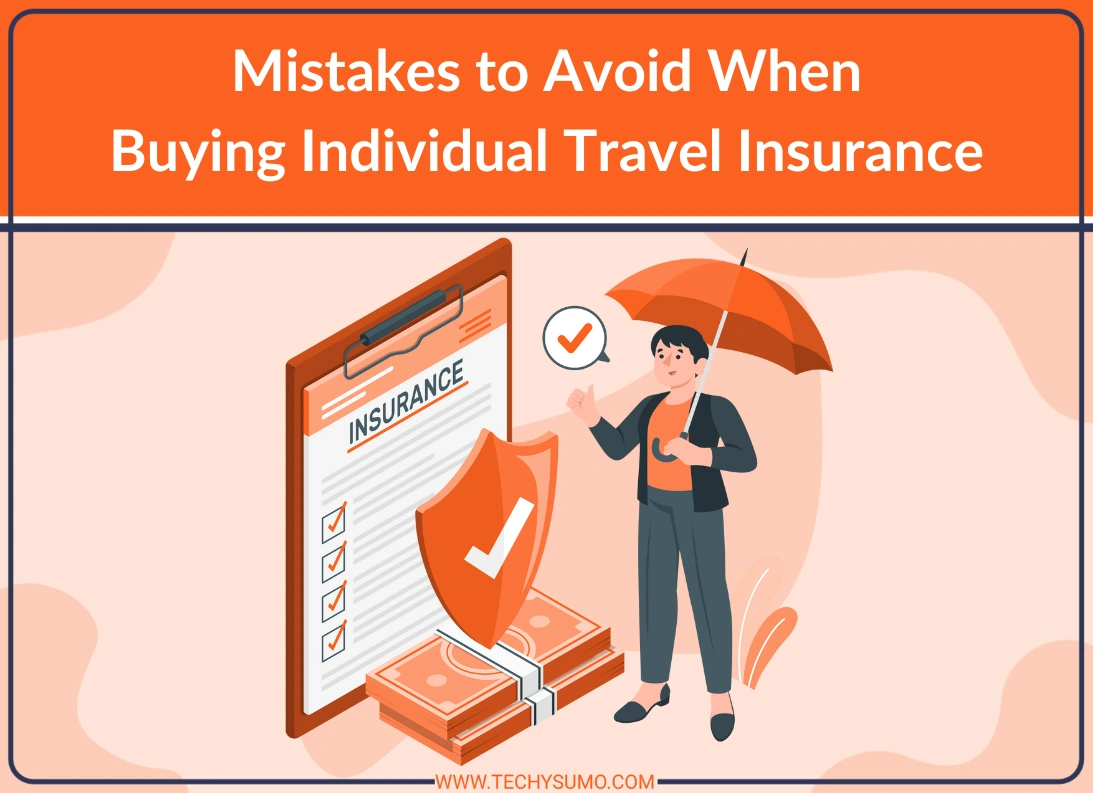Exploring the world alone can be one of the most rewarding experiences in life. However, it does put all the risk, like unexpected situations, from flight delays to medical emergencies, etc, on you. In such situations, individual travel insurance becomes essential for solo travellers, offering crucial protection when unexpected events disrupt your plans.
In this blog, you can observe what the most common individual travel insurance mistakes buyers make, and ask yourself, what steps can you take to avoid these common mistakes when buying solo travel insurance?
Table of Contents
- 1. Waiting Too Long to Buy Coverage
- 2. Selecting a Plan Based Simply on the Lowest Cost
- 3. Ignoring Expenses Related to Medical Evacuation
- 4. Ignoring Destination-Specific Risks
- 5. Neglecting to Check Sub-Limits and Exclusions
- 6. Assuming All Claims Are Cashless
- 7. Forgetting to Update Policy with Changes
- 8. Failing to Declare Pre-Existing Conditions
- 9. Assuming Travel Insurance Covers Everything
- 10. Forgetting about the Claims Process
- 11. Buying More Than One Policy for a Trip
- 12. Skipping Travel for High-Risk Sports and Activities
- Final Thoughts
1. Waiting Too Long to Buy Coverage
One of the major pitfalls is to wait until afterwards, or worse, afterwards, before purchasing travel insurance. A lot of policies require you to purchase and activate, even after departure, but the sooner you purchase your policy after booking flights and lodging, the sooner you are covered.
2. Selecting a Plan Based Simply on the Lowest Cost
Finding the lowest cost plan is very appealing, but it’s a trap we commonly see. A low-cost plan often has limited coverage, high deductible costs or exclusions. Instead of simply comparing the price of coverage, compare what you get with that premium sum insured for medical emergencies, baggage coverage, trip cancellation, etc.
3. Ignoring Expenses Related to Medical Evacuation
The most expensive claim in individual travel insurance programs is the cost of medical evacuation or repatriation. Many travellers plan on relying on their regular health insurance or buying travel solo insurance for coverage related to medical evacuation, but that certainly is not the case.
Also Read
Imagine that your travel insurance does not provide emergency evacuation. In that case, you could be in a position where you owe a huge financial payment to get you home safely due to your medical situation.
4. Ignoring Destination-Specific Risks
Every nation or region presents its own set of challenges and risks: natural catastrophes, healthcare environment, local laws, medical inflation, and more. Make sure to check the limits or coverage under your specific plan before travelling.
A plan may have a much higher limit, better network of hospitals, etc., for developed countries as opposed to a lower perceived risk country.
5. Neglecting to Check Sub-Limits and Exclusions
Many travellers glance only at the “sum insured” but miss sub-limits. An individual travel insurance plan might cap room rent, diagnostic tests, or ICU charges differently.
Also, standard exclusions like cosmetic treatments or self-inflicted injury may not be obvious. Read policy wordings carefully. Identify sub-limits for hospital room, prescription drugs, and emergency dental.
6. Assuming All Claims Are Cashless
Some people believe a travel insurance policy guarantees “cashless hospitalisation.” However, cashless facilities are often limited to network hospitals and specific types of coverage, such as certain claims, including repatriation or missed flights.
Understand which hospitals are in the insurer’s network in your destination country, and whether “cashless” applies to your specific needs. Be ready to pay upfront and later claim reimbursement if necessary.
7. Forgetting to Update Policy with Changes
Plans may change, travel dates may change, or you may decide to extend your trip or add another stop on your trip. However, if you are travelling on a new travel date or to a new destination, and you do not communicate this to the insurer, you have put yourself at risk of not being covered for the new travel date and/or destination.
Obtain a plan that allows you to amend and extend a policy, and then you should always be thinking about your travel itinerary. Make sure to notify the insurer if you change your itinerary.
8. Failing to Declare Pre-Existing Conditions
If you have a chronic illness or known condition, failing to declare it is a risky move. The insurer may reject your claim if it discovers it later, claiming non-disclosure.
Many policies exclude pre-existing conditions unless you buy a rider or special add-on. Always disclose any health issues. Seek a policy or add-on cover that caters to pre-existing illnesses if needed.
9. Assuming Travel Insurance Covers Everything
Even with comprehensive policies, there are limits and exclusions, even for common catastrophes. Events such as war, terrorism, nuclear incidents, certain high-risk sports, and even a change of mind or an act of God may not be entirely governed by your policy.
Know precisely what is and is not covered. If you’re planning to undertake extreme sports or activities, inquire about optional coverage or add-ons.
10. Forgetting about the Claims Process
A policy is only as effective as its claims procedure. When the process is slow, lengthy, or simply unresponsive, a covered claim can become an economic disaster. Some travellers don’t even check to see if their insurer has support in different languages, especially important when you’re travelling alone.
Select insurers that offer assistance hotlines where you are based, clearly outlined claim procedures, and efficient claims settlement.
11. Buying More Than One Policy for a Trip
Some travellers mistakenly think that buying more than one travel insurance policy for the same trip means they might “stack” benefits. In truth, most insurance companies will refuse to provide claims, or in any case limit claims, where there is discovered duplication of insurance.
One good travel insurance policy is better than multiple duplicate policies. If you need additional coverage, ask about add-ons instead of purchasing a policy for each possible risk.
12. Skipping Travel for High-Risk Sports and Activities
If your solo trip includes high-risk activities, such as scuba diving, trekking, or skydiving, standard travel insurance may not provide coverage for these. Not adding that kind of coverage is a standard error.
Double-check that the policy does cover your intended activities. If not, search for travel insurance policies or riders that include adventure sports coverage.
Final Thoughts
Purchasing stand-alone national or international travel insurance isn’t just a tick box on your packing list; it is an essential protection tool for your travels. Following the points that should be avoided above will ensure that when something goes wrong, your travel insurance actually works for you instead of leaving you stranded.
Particularly for stand-alone travel insurance, it’s essential to understand precisely what you’re actually purchasing: medical emergency coverage, evacuation, and claims process from your provider. As travel is unpredictable, a thoughtful and careful selection leads to peace of mind while you explore the world.






